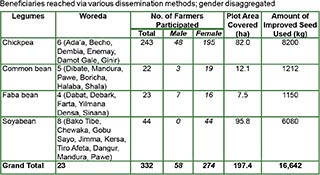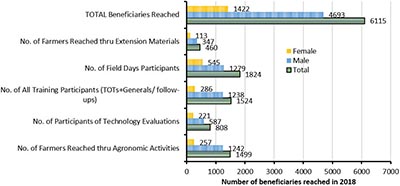The year 2018 was another exciting year for N2Africa-Ethiopia, bringing up the total number of beneficiaries so far reached by the project to 70,000 (in contrast to the 60,000 at the project completion) in 31 woredas of Amhara, Benishangul-Gumuz, Oromia and SNNP regions. The project followed the Public-Private Partnerships (PPPs) approach to achieve the project’s Visions of Success i.e. knowledge transfer, legume technology dissemination, access to input and output market. The PPPs are composed of multi-stakeholders (different public, private and development institutions) and are clustered based on the priority legume crops and geographical areas. It is gratifying to see that these PPPs got a foothold and continue to flourish and serve as platforms for networking, to access information, input supplies (seed companies, inoculant manufacturers) and output markets (private processing and export companies). In 2018 cropping season, 6133 beneficiaries have been reached through the different dissemination methods including demonstrations, adaptations, training, field days, technology evaluation events, seed multiplication and distribution of extension materials/leaflets.
| In 2018 cropping season, 6133 beneficiaries have been reached through the different dissemination methods including demonstrations, adaptations, training, field days, technology evaluation events, seed multiplication and distribution of extension materials/leaflets. |
Number of farmers participated, and quantity of improved seeds (kg) used for multiplications of certified seeds in 2018 |
Among others, availability and access to improved seed is useful for sustainability of grain legumes production. This season, 34.9 tons of improved seeds were distributed to the project target locations for planting. Compared to the quantity used for planting during any one of the seasons in the past (2014 – 2017), the amount used in the current growing season was the second largest, only preceded by that in 2016 (37 tons). In view of the relatively small number of farmers that the project engaged in 2018 (6133 farmers), the large volume of improved seeds used this season reflects the increasing interest of smallholders to involve in grain legumes production. Driven by prevailing demand for improved seeds, farmers were willing to organize themselves (under the primary farmers cooperatives unions) and engage in community seed production, thus ensuring the supply of enough quantity of certified seeds for wider cultivation of legumes in the coming season. In this season, 197 ha of land has been devoted for production of certified seeds and this will be an important input for the upcoming season, 2019. It is to be noted that 82.5% of the farmers engaged on seed production were female.
Among others, availability and access to improved seed is useful for sustainability of grain legumes production. This season, 34.9 tons of improved seeds were distributed to the project target locations for planting. Compared to the quantity used for planting during any one of the seasons in the past (2014 – 2017), the amount used in the current growing season was the second largest, only preceded by that in 2016 (37 tons). In view of the relatively small number of farmers that the project engaged in 2018 (6133 farmers), the large volume of improved seeds used this season reflects the increasing interest of smallholders to involve in grain legumes production. Driven by prevailing demand for improved seeds, farmers were willing to organize themselves (under the primary farmers cooperatives unions) and engage in community seed production, thus ensuring the supply of enough quantity of certified seeds for wider cultivation of legumes in the coming season.
| In this season, 197 ha of land has been devoted for production of certified seeds and this will be an important input for the upcoming season, 2019. It is to be noted that 82.5% of the farmers engaged on seed production were female. |  |
As the project has been running for the last five years in Ethiopia, an impact survey was conducted in Sep-Oct 2018 in two selected project woredas (Pawe for soyabean and Gonder-Zuria for chickpea intervention sites) to assess N2Africa contributions and impacts on the livelihood of smallholders. 741 respondents were interviewed, and the final report indicates a substantial level of technology adoption (up to 80% of the studied farmers)
N2Africa has produced many promising results over the last years. It is necessary to bring these results and key bottlenecks under the attention of policy makers. A draft document entitled “Policy recommendations for the legume sector in Ethiopia” has been produced in consultation with more than 20 different stakeholders involved in mainly in the N2Africa initiated PPPs and other institutions. Finally, with an aim of widely sharing the project’s success, outcomes, impacts and challenges, a short documentary video has been prepared. The video show achievements and key learning areas in N2Africa project.
Prepared by Birhan Abdulkadir, Data manager, and Endalkachew Wolde-meskel, Country Coordinator N2Africa Ethiopia
(For the full 2018 report of Ethiopia click here)

